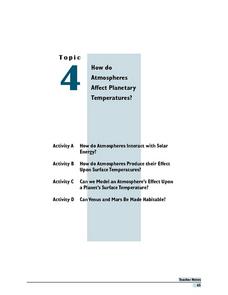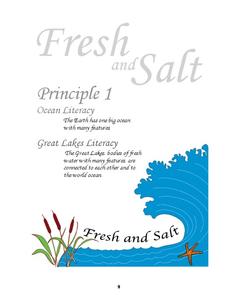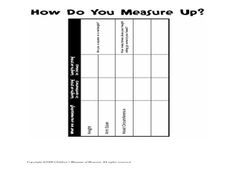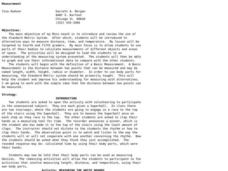Curated OER
How Do Atmospheres Affet Planetary Temperatures?
Students perform a literature search and use reputable research resources in order to find the surface temperature of different planets in our solar system. They speculate about the observed and unobserved factors. Then brainstorming is...
Curated OER
How Sweat Glands Cool Your Body
Students use water and rubbing alcohol to explain how sweat cools mammals' bodies. They write their findings in a journal. After a lecture/demo, students perform a simple experiment that demonstrates this phenomenae.
Curated OER
Geographic Effects on Precipitation, Water Vapor and Temperature
Students investigate the factors affecting climate using Live Access Server. In this geography lesson, students graph atmospheric data using Excel spreadsheet. They compare and contrast temperature, precipitation and water vapor of two...
Curated OER
How to Read a Thermometer
Students' temperature is measured using an instrument called a thermometer.
Curated OER
Deep Ocean Currents
Students observe the interactions of different temperatures of water using colored ice and a thermometer and then compare the results with global ocean current solar heating. They identify where floating ice would be found in the ocean,...
Curated OER
Amylase
Students examine what amylase is and its history. In this digestive lesson students study the effect amylase has on starch and how temperature affects the rate of activity.
Curated OER
Stop the Bleeding
Students explore various parts of the heart and blood vessels . They begin with an overview of the components of the cardiovascular system. They see a cross section of an artery and watch how a blood clot develops.
Curated OER
Viruses Quiz
In this science worksheet, students will test their knowledge of viruses. Students answer ten multiple choice questions pertaining to virus characteristics.
Purdue University
Reptiles, Amphibians, and the Scientific Method
What do a reptile and an amphibian have in common? A three-part lesson allows scholars to investigate the similarities and differences between the two types of animals by identifying specific body parts. The lesson highlights the...
Centers for Ocean Sciences
Ocean and Great Lakes Literacy: Principle 1
Is your current lesson plan for salt and freshwater literacy leaving you high and dry? If so, dive into part one of a seven-part series that explores the physical features of Earth's salt and freshwater sources. Junior hydrologists...
Curated OER
WATER QUALITY FOR FRESHWATER ORGANISMS
Students use determination of dissolved oxygen and water temperature changes to determine the environmental impact from thermal pollution.
Curated OER
The Day After Tomorrow: How is the Density of Water Related to Climate Change and Global Warming?
Science learners simulate what happens when ice breaks up and floats on water and how increased pressure on ice causes it to melt faster. They view a clip from the movie, The Day After Tomorrow, and relate their lab activities to what...
Curated OER
Using Imagery To Introduce the Endocrine System
Students listen with closed eyes to a story that starts in a relaxed tone and ends in a scream. They list the body reactions they experience: fast heart rate, shaking, etc. and hypothesize the reason for the reactions. They explore the...
Curated OER
Integumentary System: A System, An Organ, the Biggest!
It is only six short slides, but an acceptable outline of the integumentary system. General facts about the system, layers, sublayers, and functions are listed as bullet-points. What would make this presentation more engaging for your...
Curated OER
How Do You Measure Up?
Young scholars measure their body. In this measurement lesson, students use a string to measure their height and the circumference of their head. They record this information on the worksheet provided and answer questions as a group.
Curated OER
Polar Quest Expedition
Students investigate how to design a jacket that can be worn in extremely cold temperatures. They use the internet to research materials and different types of designs. As an extension to the lesson students go to a sporting goods store...
Biology Junction
Enzymes
Many people know enzymes help with digestion, but few realize enzyme production decreases with age, making it more difficult for bodies to digest certain foods. A worksheet offers 28 fill-in-the-blank and short-answer questions over...
Curated OER
Thermal Pollution
In this pollution instructional activity, students read about thermal pollution and how hot water affects wildlife. Then students complete 1 short answer question.
Curated OER
Getting Physical with Estuaries
Students study estuaries and how the physical factors change over time. In this investigative lesson students use a website to gain knowledge of estuaries then in groups they create and present their charts.
Curated OER
Measurement
Students study the metric system and examine other ways to measure. In this measurement lesson students complete activities that help them to better understand the measuring system.
Curated OER
Field Trip to test Water Quality
Students examine water quality indicators,test water quality and record their results. In this water quality lesson students complete a water testing lab and complete a lab report.
Curated OER
Skin: The Body's Protection
In this skin worksheet, students will compare the characteristics of the epidermis and the dermis. Then students will complete 2 short answer questions.
Curated OER
Animal Skin
Students investigate the skin surface to body area ratios for different animals. In this seventh/eighth grade mathematics/science lesson, students explore heat transfer between an animal’s body and the environment. Using technology,...
Curated OER
Taste, Smell, Touch
Students explore the senses, taste, touch and smell. In this lesson about senses, students perform experiments, or activities. Students complete three activities in order to become more familiar with the three senses of taste, touch, and...
Other popular searches
- Body Temperature Regulation
- Body Temperature Control
- Body Temperature in Animals
- Normal Body Temperature
- Control of Body Temperature
- Altered Body Temperature
- Controlling Body Temperature
- Measuring Body Temperature
- Body Temperature Taking
- Maintaining Body Temperature
- Body Temperature Regualation
- Altered Body Temperature Ppt

























